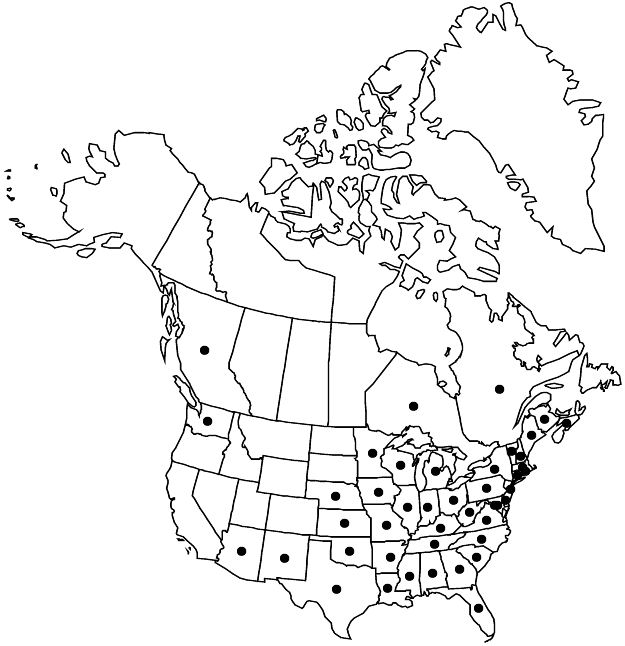Prunus serotina
Gartenkalender 3: 285. 1784.
Shrubs or trees, not suckering, 40–400 dm, not thorny. Twigs with terminal end buds, glabrous or hairy. Leaves deciduous; petiole 2–23(–30) mm, glabrous or sparsely to densely hairy, usually glandular distally or at petiole-blade junction, glands 1–6; blade usually narrowly elliptic, oblong-elliptic, or obovate, sometimes lanceolate, rarely ovate, 2–13.5 × 1.1–6.5 cm, base cuneate to rounded, margins crenulate-serrulate to serrate, teeth incurved or appressed, sharp or blunt, glandular or callus-tipped, apex usually acute to acuminate, sometimes obtuse, rounded to emarginate in var. alabamensis, lateral veins 15–30 per side, flush abaxially, abaxial surface usually densely hairy along midribs proximally, sometimes glabrous or sparsely hairy, adaxial glabrous. Inflorescences 18–55(–90)-flowered, racemes; central axes (25–)35–160 mm, leafy at bases. Pedicels 1–10 mm, glabrous or hairy. Flowers blooming after leaf emergence; hypanthium cupulate, 1.5–3 mm, glabrous externally; sepals erect-spreading to reflexed, semicircular, 0.5–1.5 mm, margins usually entire, rarely glandular-toothed, rarely ciliate, surfaces glabrous; petals white, obovate to suborbiculate, 2–4 mm; ovaries glabrous. Drupes dark purple to nearly black, globose, 5–10[–25] mm, glabrous; hypanthium persistent; mesocarps fleshy; stones subglobose, not flattened.
Distribution

B.C., N.B., N.S., Ont., Que., Ala., Ariz., Ark., Conn., D.C., Del., Fla., Ga., Ill., Ind., Iowa, Kans., Ky., La., Maine, Mass., Md., Mich., Minn., Miss., Mo., N.C., N.H., N.J., N.Mex., N.Y., Nebr., Ohio, Okla., Pa., R.I., S.C., Tenn., Tex., Va., Vt., W.Va., Wash., Wis., Mexico, Central America, South America, introduced in Europe.
Discussion
Varieties 4 (3 in the flora).
Variety capuli (Cavanilles) Hatusima [subsp. capuli (Cavanilles) McVaugh] is known from Mexico (Chiapas, Jalisco, Distrito Federal, México, Puebla), Central America, and South America (Argentina, Bolivia, Colombia, Ecuador, Peru, Venezuela). It is distinguished from var. serotina by lanceolate to ovate-lanceolate leaves with decurrent bases (versus elliptic to obovate with obtuse to cuneate bases) and a long (to 2 cm), thin (1 mm) petiole; inflorescences tend to be subtended by 3 or 4 leaves [versus 2 (or 3), reduced in size], with a rachis relatively longer (greater than 15 cm), thicker, and flexuous compared to other varieties, and shorter pedicels (3–5 mm versus 5–10 mm, in var. serotina).
The characters given in the key usually allow easy separation of Prunus serotina from P. virginiana; some specimens from Arizona and southern Utah are difficult to determine. In that area, it is not uncommon for the sepals of P. virginiana flowers to lack the glandular teeth that are common elsewhere and thus mimic those of P. serotina. Variety rufula has thicker leaves that are also much shinier on both surfaces than those of P. virginiana and shorter petioles (2–15 mm versus 4–27 mm).
Compounding the confusion with chokecherry is a nomenclatural conundrum in which the epithet virginiana has been used for both chokecherry (the next species) and for black cherry (this species). The status of the two names Prunus serotina and P. virginiana was discussed by K. N. Gandhi et al. (2009), who proposed the conservation of both names.
Of our native Prunus species only P. serotina grows large enough to produce commercial lumber, which is highly prized for its fine grain and rich, warm, reddish brown color.
Selected References
None.
Lower Taxa
Key
| 1 | Leaf blades elliptic to obovate, abaxial surfaces sparsely hairy, apices usually obtuse, rounded, or emarginate, sometimes abruptly acute or short-acuminate. | Prunus serotina var. alabamensis |
| 1 | Leaf blades usually elliptic, lanceolate, or oblong, rarely obovate or ovate, abaxial surfaces glabrous or midribs hairy, apices acute to acuminate | > 2 |
| 2 | Leaf blades 4–13.5 cm, membranous or slightly leathery; petioles (7–)10–23(–30) mm; e North America. | Prunus serotina var. serotina |
| 2 | Leaf blades 2–5.2(–7.4) cm, leathery; petioles (2–)4–10(–15) mm; Arizona to w Texas. | Prunus serotina var. rufula |